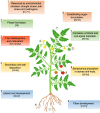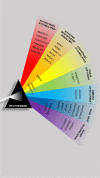The NAC side of the fruit: tuning of fruit development and maturation
- PMID: 34044765
- PMCID: PMC8157701
- DOI: 10.1186/s12870-021-03029-y
The NAC side of the fruit: tuning of fruit development and maturation
Abstract
Fruits and seeds resulting from fertilization of flowers, represent an incredible evolutionary advantage in angiosperms and have seen them become a critical element in our food supply.Many studies have been conducted to reveal how fruit matures while protecting growing seeds and ensuring their dispersal. As result, several transcription factors involved in fruit maturation and senescence have been isolated both in model and crop plants. These regulators modulate several cellular processes that occur during fruit ripening such as chlorophyll breakdown, tissue softening, carbohydrates and pigments accumulation.The NAC superfamily of transcription factors is known to be involved in almost all these aspects of fruit development and maturation. In this review, we summarise the current knowledge regarding NACs that modulate fruit ripening in model species (Arabidopsis thaliana and Solanum lycopersicum) and in crops of commercial interest (Oryza sativa, Malus domestica, Fragaria genus, Citrus sinensis and Musa acuminata).
Keywords: Fruit; NAC; Ripening; Senescence; Transcription factor.
Conflict of interest statement
The authors declare that they have no competing interests.
Figures



Similar articles
-
Molecular programme of senescence in dry and fleshy fruits.J Exp Bot. 2014 Aug;65(16):4515-26. doi: 10.1093/jxb/eru093. Epub 2014 May 29. J Exp Bot. 2014. PMID: 24874021 Review.
-
Transcriptional control of fleshy fruit development and ripening.J Exp Bot. 2014 Aug;65(16):4527-41. doi: 10.1093/jxb/eru316. J Exp Bot. 2014. PMID: 25080453 Review.
-
Genetics and control of tomato fruit ripening and quality attributes.Annu Rev Genet. 2011;45:41-59. doi: 10.1146/annurev-genet-110410-132507. Annu Rev Genet. 2011. PMID: 22060040 Review.
-
Tomato fruit ripening factor NOR controls leaf senescence.J Exp Bot. 2019 May 9;70(10):2727-2740. doi: 10.1093/jxb/erz098. J Exp Bot. 2019. PMID: 31002305 Free PMC article.
-
Suppression of tomato SlNAC1 transcription factor delays fruit ripening.J Plant Physiol. 2016 Apr 1;193:88-96. doi: 10.1016/j.jplph.2016.01.014. Epub 2016 Feb 26. J Plant Physiol. 2016. PMID: 26962710
Cited by
-
Overview of Repressive miRNA Regulation by Short Tandem Target Mimic (STTM): Applications and Impact on Plant Biology.Plants (Basel). 2023 Feb 3;12(3):669. doi: 10.3390/plants12030669. Plants (Basel). 2023. PMID: 36771753 Free PMC article. Review.
-
The NAC transcription factors play core roles in flowering and ripening fundamental to fruit yield and quality.Front Plant Sci. 2023 Feb 23;14:1095967. doi: 10.3389/fpls.2023.1095967. eCollection 2023. Front Plant Sci. 2023. PMID: 36909440 Free PMC article. Review.
-
The transcription factor VviNAC60 regulates senescence- and ripening-related processes in grapevine.Plant Physiol. 2023 Jul 3;192(3):1928-1946. doi: 10.1093/plphys/kiad050. Plant Physiol. 2023. PMID: 36718552 Free PMC article.
-
Genomic region and origin for selected traits during differentiation of small-fruit cultivars in Japanese apricot (Prunus mume).Mol Genet Genomics. 2023 Nov;298(6):1365-1375. doi: 10.1007/s00438-023-02062-w. Epub 2023 Aug 26. Mol Genet Genomics. 2023. PMID: 37632570
-
Transcriptional Control of Seed Life: New Insights into the Role of the NAC Family.Int J Mol Sci. 2024 May 14;25(10):5369. doi: 10.3390/ijms25105369. Int J Mol Sci. 2024. PMID: 38791407 Free PMC article. Review.
References
-
- Lorts CM, Briggeman T, Sang T. Evolution of fruit types and seed dispersal: a phylogenetic and ecological snapshot. J Syst Evol. 2008;46:396–404.
-
- Knapp S, Litt A. Fruit-an angiosperm innovation. In: The molecular biology and biochemistry of fruit ripening. Oxford: Blackwell Publishing Ltd.; 2013. p. 21–42. 10.1002/9781118593714.ch2.
-
- Wallace TC, Bailey RL, Blumberg JB, Burton-Freeman B, Chen CO, Crowe-White KM, et al. Fruits, vegetables, and health: a comprehensive narrative, umbrella review of the science and recommendations for enhanced public policy to improve intake. Crit Rev Food Sci Nutr. 2019;60:2174–211. doi: 10.1080/10408398.2019.1632258. - DOI - PubMed
-
- Mason-D’Croz D, Bogard JR, Sulser TB, Cenacchi N, Dunston S, Herrero M, et al. Gaps between fruit and vegetable production, demand, and recommended consumption at global and national levels: an integrated modelling study. Lancet Planet Health. 2019;3:e318–29. doi: 10.1016/S2542-5196(19)30095-6. - DOI - PMC - PubMed
Publication types
MeSH terms
Substances
Grants and funding
LinkOut - more resources
Full Text Sources
Other Literature Sources
Research Materials

